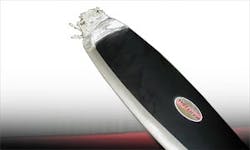There was a time when propeller blades were made of wood — until metal blades were invented. Now, to round out the selection, propellers are also being made of composited layers of carbon fiber or Kevlar (or both) surrounding a shock-absorbing foam core. The reason: composite blades are lighter than metal and stronger than wood. In fact, a four-blade composite weighs the same as a three-blade metal, providing a quieter, smoother flight without extra fuel consumption.
Hartzell Propellers of Piqua, OH, knows all about composite props. The company that made its first wooden propellers for the legendary JN4 Jenny in 1917 ventured into advanced composite propellers more than 30 years ago. Today, Hartzell composite props can be found on the Cirrus SR22, many aerobatic aircraft, Beech 1900C and D, and the Shorts SD3-60 (a.k.a the 360), among others.
So how does one maintain and repair a composite propeller blade? To find out, we spoke to Mark Spoltman, Hartzell’s engineering manager of composites.
Same threats,
Different responses
Composite blades face the same threats as their wooden and metal cousins. The most common are nicks caused by stones or other objects getting swept up in the propeller wash. Other risks include damage caused by impact with external objects such as fences, vehicles, other aircraft on the ground, or the ground itself.
With metal propellers, the remedy is to remove material by filing, sanding, and polishing. “Unfortunately, metal can only be removed and each repair distorts the aerodynamic shape and steals a little bit of life,” says Spoltman. “Once minimum dimensions have been hit, the blade must be replaced — a costly proposition.”
Composite blades also get damaged, but whereas metal can only be removed, composite can be restored. In fact, “Almost all Hartzell propeller blades are certified with an infinite fatigue life,” he says. “Many metal blades must be retired due to on-condition issues caused by the removal of material during repair. Therefore, when the metal blade owner is looking at costly blade replacement, the composite blade owner is still going strong with all of the original performance still in place.”
The repair of composite blades starts out essentially the same as metal with removal of the damage, but there’s an extra stage required.
“The aircraft technician does sand down nicks on a composite blade,” says Spoltman. “To do this properly, you begin by starting at the deepest part of the nick, then working your way back to the undamaged area in a 360-degree pattern. This smooths out the divot while minimizing the amount of material being removed.”
Once this stage has been completed, the sanded area is built up using layers of fiberglass and resin. When this has cured, the fiberglass is then sanded down such that the patched blade shape matches the original in size, shape, and thickness. At this point you paint it, and you are ready to go.
Composite blades are coated with a durable paint that can be time-consuming to replace. To speed the process, smaller repairs are permitted to use an aerosol process.
“The limits on the faster repair are not arbitrary and must be adhered to,” he warns. As well, “Many composite blades have a conductive paint layer for the proper dissipation of precipitation static. Therefore, larger repair areas require the re-application of the conductive coating. You do not want the propeller to be the source of a p-static problem.”
Sometimes the damage is to a blade’s leading edge. On a metal propeller, the answer is once again to remove the material. On a composite propeller, the leading edge is protected with a secondary structure manufactured from nickel (an erosion shield) that can be replaced.
The damaged erosion shield is removed by first debonding it from the blade using a propane torch, while being careful not to damage the composite material. Once removed, the leading edge area is cleaned of residual adhesive and inspected for damage. A new erosion shield, which has been prepared for bonding by the factory with a metal preparation process followed by an adhesive primer, is glued in place using a special adhesive paste purchased from the manufacturer.
“We put the blade inside a vacuum bag, to eliminate any bubbles and ensure a really tight fit,” says Spoltman. “In either case, the adhesive cures in 12 hours at room temperature; two to three hours at 140 F to 150 F.”
Once the new leading edge is properly bonded to the composite blade, the unit is sanded until it matches the original spec, then painted.
When to do it yourself, and when not to
With customers always wanting their aircraft back in service yesterday, and financial pressures being what they are, it makes sense for aircraft maintenance shops to do as many repairs themselves as possible, rather than sending parts back to the manufacturer. So how do you know when you can do the work yourself and when you can’t?
“There are three levels of composite blade repairs,” says Spoltman. “These are classified as minor, major, and factory-only repair procedures.”
A minor repair is one that most qualified AMTs can do themselves. These are minor nicks that don’t require much material replacement, and cover the vast majority of repairs performed.
“Once you sand the area and apply the fiberglass, you just have to ensure that there are no areas of delamination or bubbles,” says Spoltman.
A major repair occurs when the nick is significant — something that is more than superficial, in other words.
“These are the kinds of repairs that require a vacuum pump to ensure proper lamination, and should only be done by authorized repair stations,” says Spoltman. “At the factory-only level comes substantial blade damage, including damage caused by the prop hitting the ground. For these repairs, we rebuild the composite blade using a mold that ensures the prop conforms to its specified shape and dimensions.”
A word to the wise
The idea of repairing an advanced composite blade may intimidate veteran AMTs accustomed to wooden and metal props. But there’s no need for fear.
“The technique for fixing composite blades is pretty straightforward,” says Spoltman. “You just have to be thorough. The worst thing you can do is rush through the inspection process, missing damage that needs to be fixed. Be methodical and chances are that you won’t have any problems.”


